Yesterday we followed Luis Garcia Mozos as he joined the S.I. studio in Barcelona and developed into one of its top romance artists. Today we will find him beginning to stretch his wings…
While most foreign artists were happy to draw their commissions back in their home countries, some took the chance to travel to Britain and work directly for the publishers there. Notable artists who made the journey include Hugo Pratt, Alberto Breccia, Luis Roca and Stelio Fenzo and as Luis remembers he too made several visits to London...
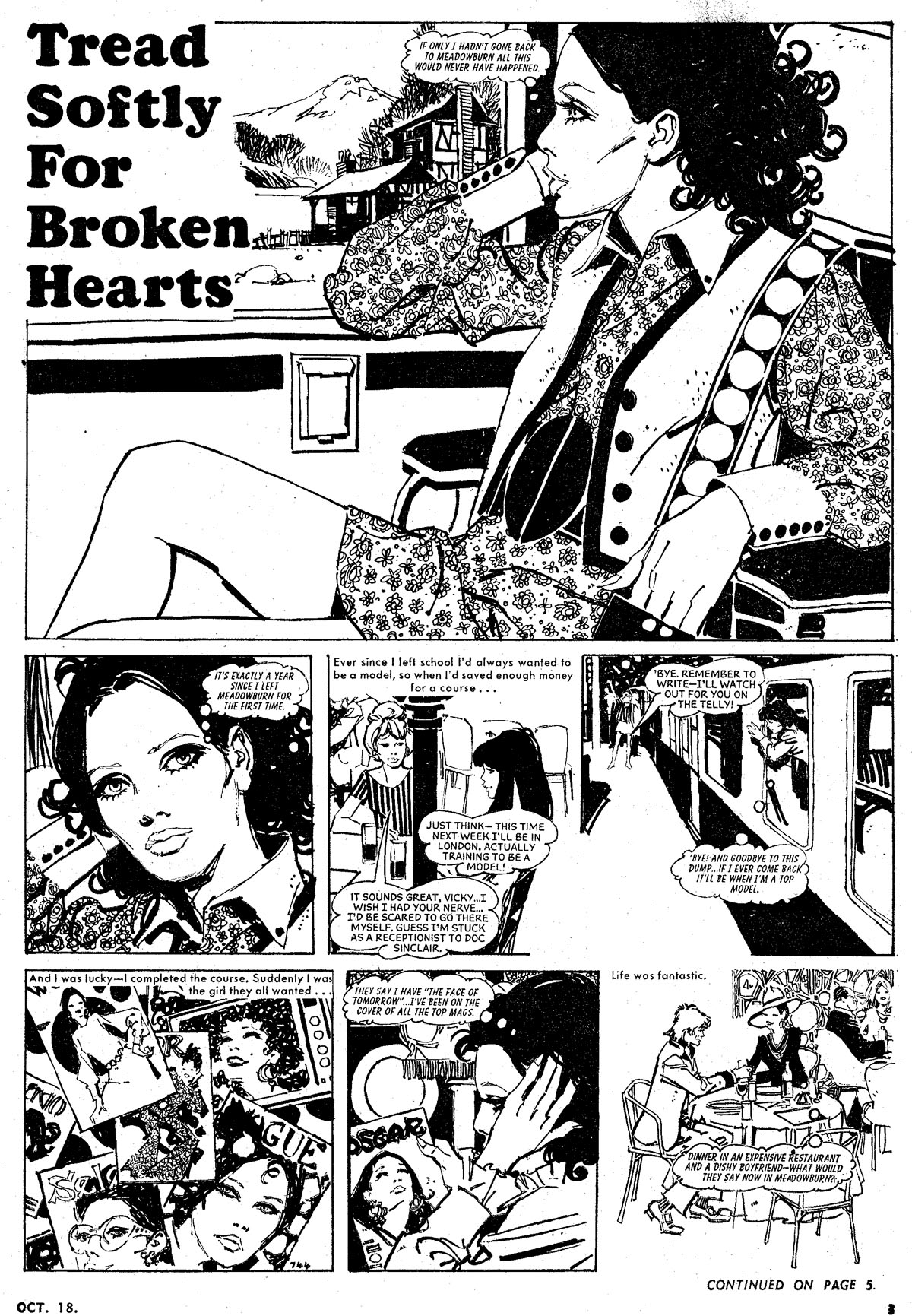
"Until the birth of my son Luis Alberto in 1991, London was the strongest experience of my life. The first time I lived in the city was for a little over a month in the Autumn of 1965 (with Luis Roca and Enrique Montserrat). The second was in 1968 for 2 months and finally in 1969 I stayed for an entire year. At first I knew no one there, but I was free to do whatever I wanted. I started making friends amongst the editorial teams I was working with at IPC Magazines. Margaret Koumy, Editor of the teen magazine 19 became my best friend and guardian angel. Another ally was Dick Lewis the story editor at Mirabelle, he was a tall, fat gentleman who was very fond of my drawings. I also met The owner of the company; a deaf, mute nobleman who had lost a son about my age in a motorcycle accident. He invited me to spend a weekend at his cottage and I can remember sitting outside his pub drinking beer watching a group of people wearing red jackets and hats sitting on horseback, accompanied by a pack of dogs chasing a fox. Another time I went to the legendary Speakeasy club With Maureen, a journalist friend of the publisher (and editor of Honey) and ended up sitting near John Lennon, accompanied by his then wife Cynthia. Eric Burdon, lead singer of The Animals, was singing on stage - a celebration of cannabis sung over a rhythym and blues backing while pouring a huge mug of beer over his head!"
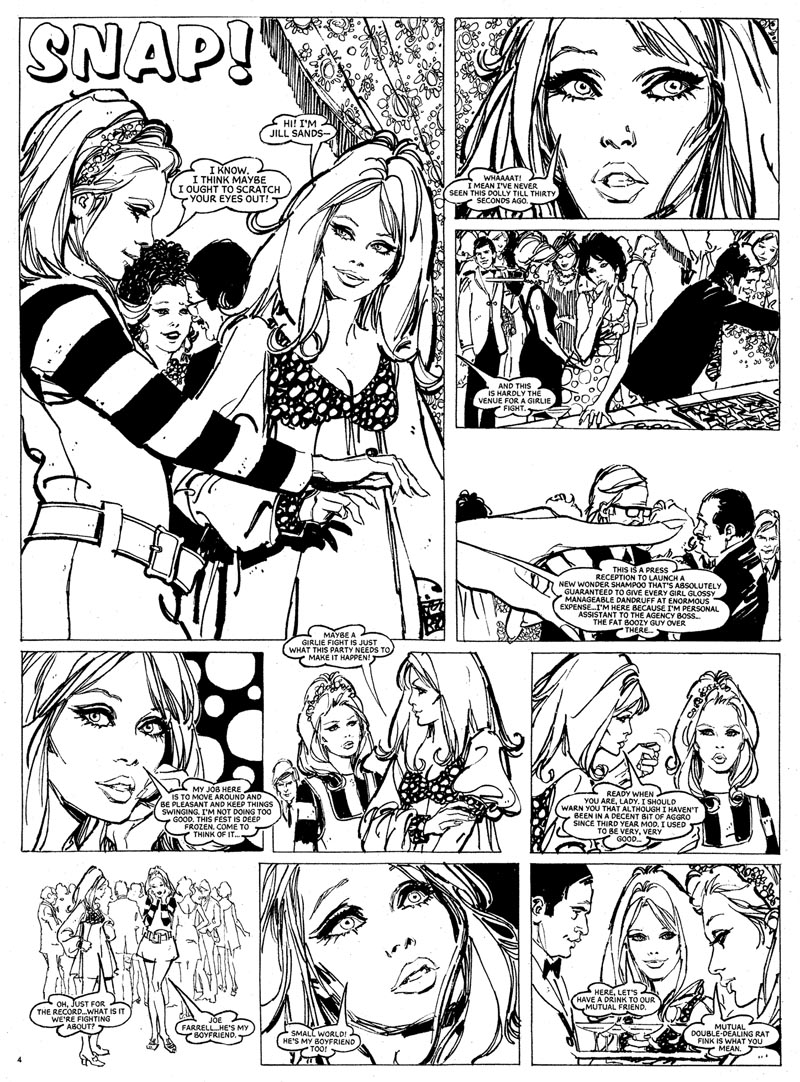
"At the beginning of this period I drew countless romance strips for Mirabelle, Valentine and Romeo and illustrations for 19. I also drew a couple of portraits of Paul McCartney and Mick Jagger which were printed up as posters and sold through ads in Mirabelle. My friends and I would set up opposite Marble Arch selling these posters and I also started drawing open air portraits. My friend from the age of 15, Maria Del Carmen Vila (better known as "Marika" who later became a comic book artist) also joined us from Spain. I found that by drawing portraits on a Sunday I could make enough money to live on for the rest of the week. I stopped drawing romances and illustrations and gave myself the full hippie experience: counterculture, Buddhism, Hinduism, free love, sexual revolution, marijuana, hashish, LSD... At the beginning of the last "trip" I had with LSD (a "Vulcan"), I saw in three dimensions "The Battle of Thermopylae” (from the comic strip Mort Cinder by Alberto Breccia) on the gray carpet. Someone said something that turned the trip bad, I lost control and went into paranoia. Everything happened very fast: panic, fainting, police station, light-headedness, hospital. It was a "Satory", a revelation, a complete break. The experience of the "Vulcan" coupled with chronic flu forced me to return home to Barcelona."
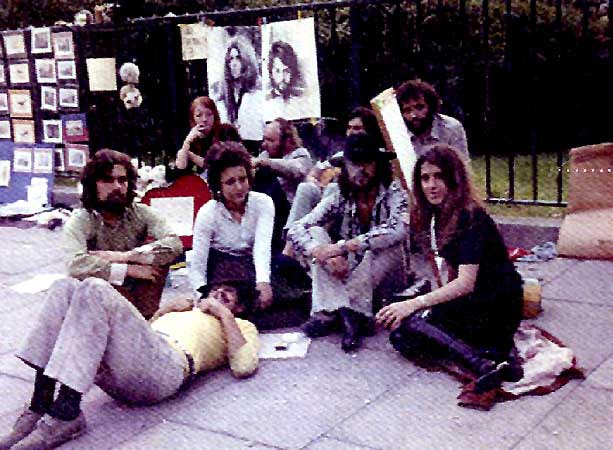
(Above: Luis (in hat) selling posters in Marble Arch, London, 1970. With Margaret Koumy to his left and Marika to his right)
On his return he eventually resumed his romance work, mostly for Jackie and Romeo which by this point were featuring some spectacularly good artwork. In addition to Luis a typical issue from 1970 could feature work by Pepe Gonzalez, Felix Mas, Ramon Torrents, Jose Maria Bea, Esteban Maroto and Adolfo Usero. A year later this same group of artists could be found in the U.S. in almost every issue of the Warren comic magazines Creepy, Eerie and Vampirella. Warren had made a big impact in the mid '60s when its magazines reintroduced horror comics to the U.S newsstands a decade after the genre was effectively wiped out by a combination of media witch hunts and industry self-censorship. After a thrilling first few years which had seen the company reunite many of the artists from the legendary E.C comics line, Warren had gone into a steep economic and artistic decline from which it was only just beginning to emerge. When publisher Jim Warren was contacted by S.I.’s Josep Toutain in 1971 the work he saw was a revelation and the resulting flood of artwork from Spain transformed the company’s fortunes.

“The first Spanish artist to work for Warren was Carlos Prunes who contacted the company personally without any intermediary agencies. After this Toutain travelled to the U.S and got work from the company for all of us. After returning home I talked to Toutain and told him I did not want to draw any more romances, instead I asked him to give me work in the Warren magazines. Among the strips I drew one of the most memorable was "The Men Who Called Him Monster." On the one hand, I identified with the protagonist (a werewolf) who had a compulsion to harm others and fled to avoid this (a guilt complex that reminded me that I was taught by the Brothers of La Salle). On the other, I began to enjoy the narrative possibilities of the story. Medium shots, dramatic lighting ... I could now investigate the narrative aspects, technical and formal. The system of work was similar to the UK market: we had no contract, the scripts were translated and then we drew the originals which were then sent on to the publisher. The only differences were that we could sign the pages and collect royalties from sales to other countries."
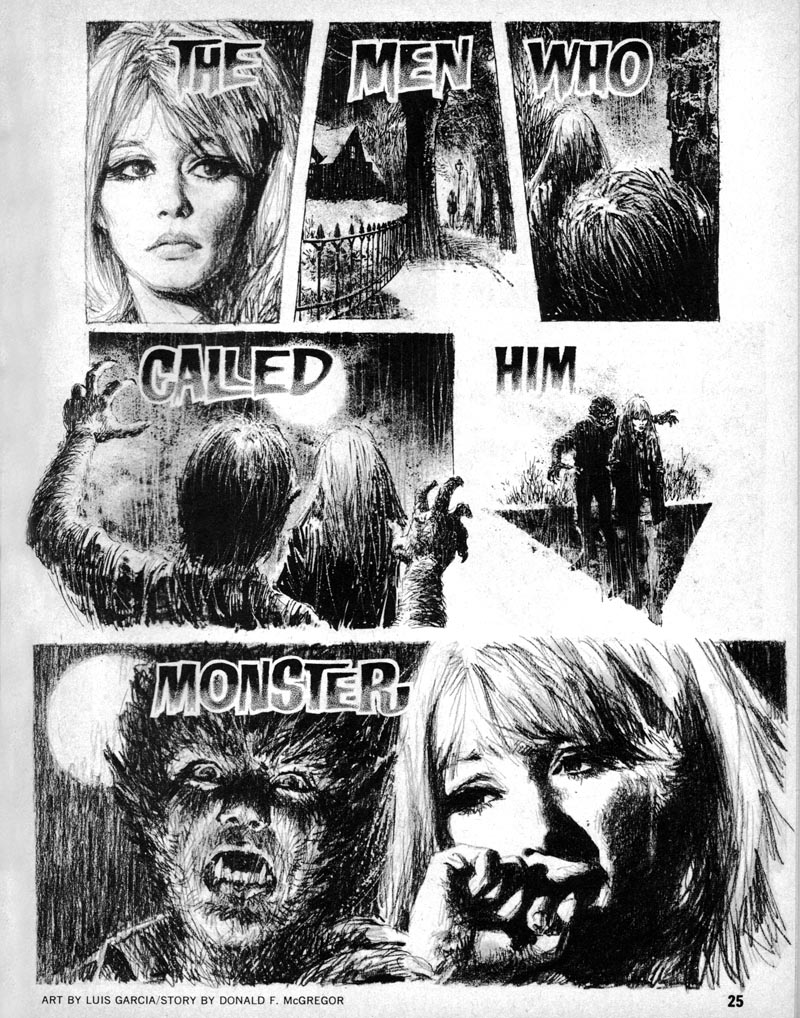 (Above: Page 1 of Luis’ first strip for Warren Publications. Page 6 features comic's first interracial kiss. Modelled by Sydney Poitier and Carol de Haro)
(Above: Page 1 of Luis’ first strip for Warren Publications. Page 6 features comic's first interracial kiss. Modelled by Sydney Poitier and Carol de Haro)The Spanish artists quickly came to dominate Warren's magazines For them it was a chance to cast off the shackles of endless romances, for their audience it was artwork unlike anything they had ever seen before. Prior to the Spanish invasion pretty much all American comic book artists ( Bernard Krigstein excepted ) could trace the foundations of their styles to the great triumvirate of Alex Raymond, Hal Foster or Milton Caniff. The Spaniards were different; they were in thrall to the Italian artist Dino Battaglia and most crucially to Alberto Breccia. What Breccia had shown them, particularly in his early '60s masterwork, Mort Cinder, was that comics needn’t look the way they had always looked - anything that makes a mark could be used to draw comics. Breccia’s strips might contain line work mixed with collage, texture rubbings, scratches, tones, photographs or anything that might come to hand. His drawings owed as much to German expressionism as anything else and In his constant questing for innovation, creativity and self expression he was a supremely liberating influence. His impact on the S.I. artists was profound and no one felt that influence more keenly than Luis.

I wonder if any artist has ever so completely transformed his approach to comics as Luis did in 1971? Straight after putting down his final romance strip for Romeo he launched into his Warren work, which combined ultra-realistic drawing, rendered in various combinations of ink or graphite, with the most extraordinarily rich array of tones and scratches. While there are the faintest echoes of his old drawing style still visible under the new surface patina, the reader could be forgiven for thinking they were two completely different artists.
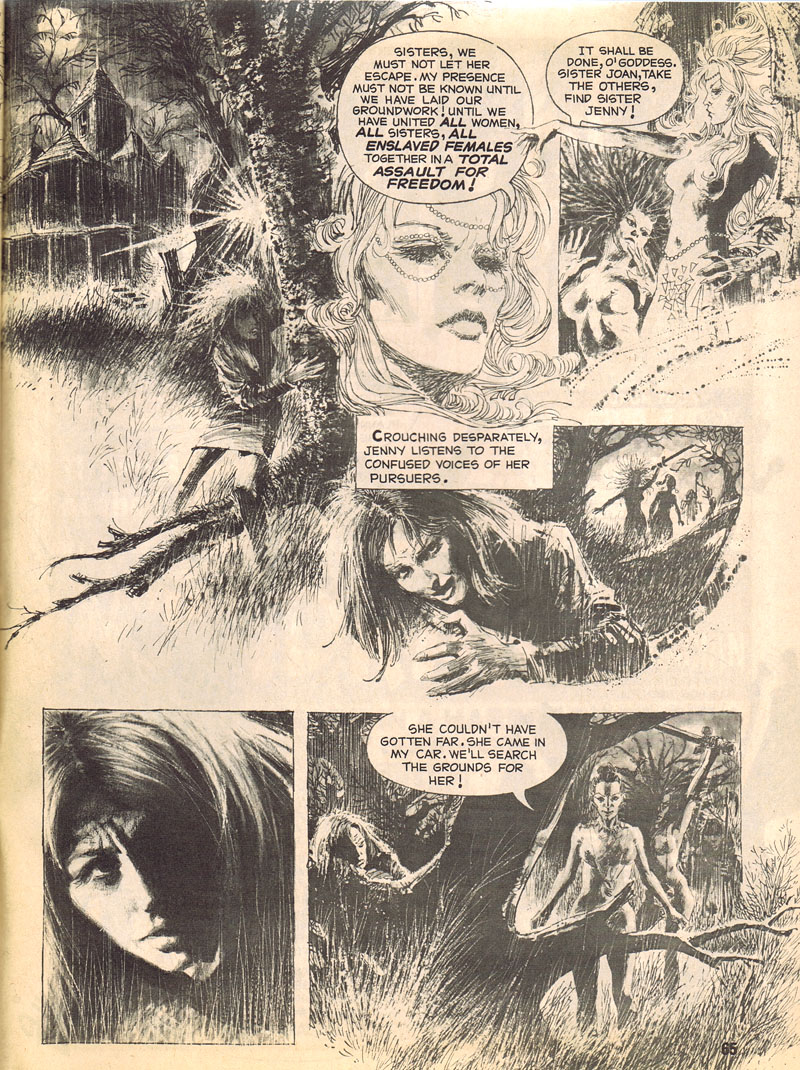
Throughout 1972, nine of these striking, experimental and arresting strips emerged – making almost 100 pages in total; an extraordinary rate of production for such accomplished images. While many fans embraced the Spanish new look others reacted with confusion and hostility. For them it was too far removed from the artwork they had grown up with, it’s reference points were too obscure and it was taking inspiration from traditions beyond their understanding. Some saw it all as self indulgent, the product of cheap foreign labour with no idea of how to tell a story (an opinion that still pops up from time to time). I see it rather differently. To me it was Spains’ golden generation cutting loose after a decade shackled to the most conservative comic producing nation in the world.
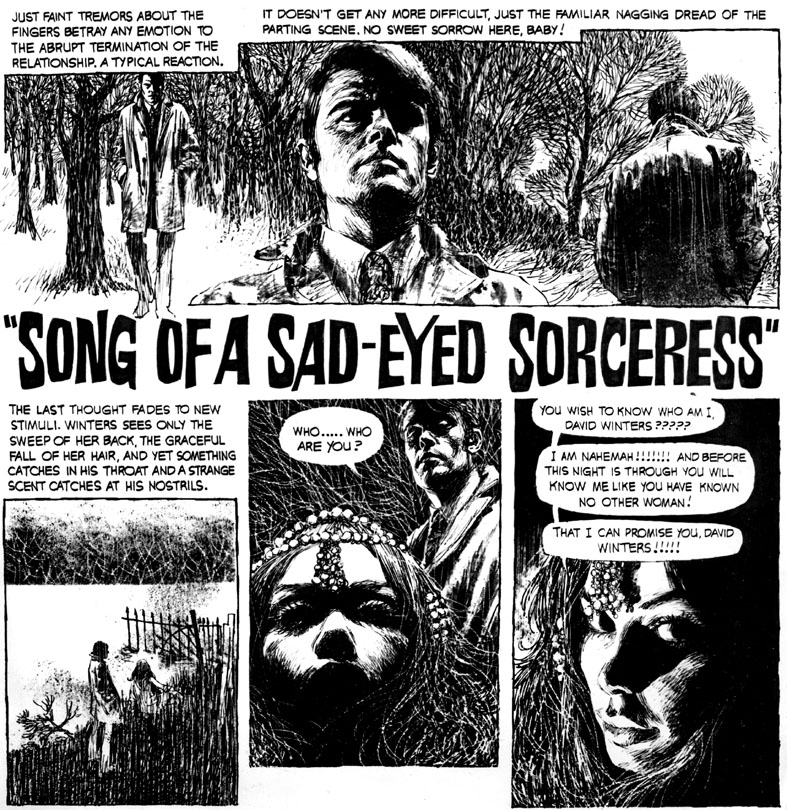
The very striking girl at the heart of "Song Of A Sad Eyed Sorceress" was based on Carol de Haro who had been Luis’ co-star in several '60s Photonovels.

When Carol returned from a period living in the U.S. she met up again with Luis – who had himself just returned from London and their reunion had an unexpectedly profound effect for the world of comics, as Luis remembers...
”Carol de Haro, besides being my model and my girlfriend was also the Vampirella model for Pepe Gonzalez’ drawings of Vampirella. Most importantly, Carol was the model for the poster-size color painting of Vampirella. Gonzalez drew the picture in the first place which was then painted by Enric Torres (for the cover of Vampirella 19, subsequently used as an iconic 6ft high poster) and Enric also used her as a model."

"Carol was my "Muse", the "Muse" of Gonzalez, Enric... and many others who also drew comic covers or illustrations."
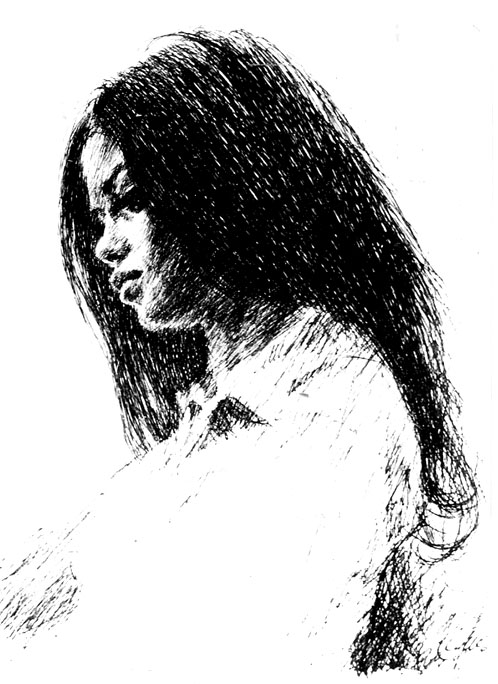
Enric clearly used Carol as the model for most of his early Vampirella covers and her stunning features clearly inform Gonzalez’ interpretation of the character as well. She would go on to star in many of Luis’ later strips as well as, after a year working at Warren, he turned his attention to Europe. Looking back at this period today he reflects that, “The most important aspect of my work for Warren, was the chance to investigate technique, dramatic lighting effects and to establish my own comic style. I was bored with the drawing techniques of my romances and I wanted to change my art completely. After testing and learning in the Warren magazines I found my own character in the Cronicas del sin Nombre series (drawn a year later for the French magazine Pilote). But I am very grateful and pleased to have drawn for Warren, otherwise perhaps I would have continued doing romance comics for the U. K. Without the experience of working for the Warren magazines, I could not have developed the style that I did for France.”
Next: Dali and Paris
Fascinating article and gorgeous art.
ReplyDeleteA
This is a great look at comic work done outside of the American fish bowl. As much as I adore the work of people like Hal Foster and Alex Raymond, it's easy to forget that vastly different artistic traditions have developed throughout the rest of the world. It's so easy to stop experimenting, to stop pushing the medium, and to keep referencing the tried and true.
ReplyDeleteHey, I am new to your blog. That's lovely work you have a knack of finding. I'll keep checking back!
ReplyDeleteWorth the wait. Thanks Leif for sharing Davids profile of Luis Garcia Mozos. What a draftsman, great cosmetics!
ReplyDeleteHave been a big fan of LGM since I discovered his work for Vampirella. I agree with the other commenter, his use of mascara was a highlight.
ReplyDeleteThank you so much for posting. Also greatly enjoyed the Jack Davis post.
TI is my favorite blog. (And that's saying something!)
It's so cool to see Warren artists finally written about!
ReplyDeleteI collected these in the 70's and they were endless inspiration to me-there were some big names illustrating for them, but I had no idea who all of these Spanish sounding named guys were doing this fantastic artwork. Thanks for giving us some background information and stories. The Vampirella poster was burned into by brain back then and still remains an icon of (undead) sexiness in illustration.
Excellent blog!! This is one of the best about illustration that I've ever found.
ReplyDeleteYou should consider to dedicate a post to some of the other great Spanish artists that worked for Warren: Esteban Maroto (still alive and you can see him drawing in my youtube channel), Fernando Fernandez, Luis Bermejo and many others.
You can find an excellent picture of Pepe Gonzalez & Enric's Vampirella's original here (7mb): http://www.jhalpe.com/items/view/2026
ReplyDeleteThank you for this great post and this great site.
These are very good suggestions.
ReplyDeletePlease also check https://candogseatt.com/